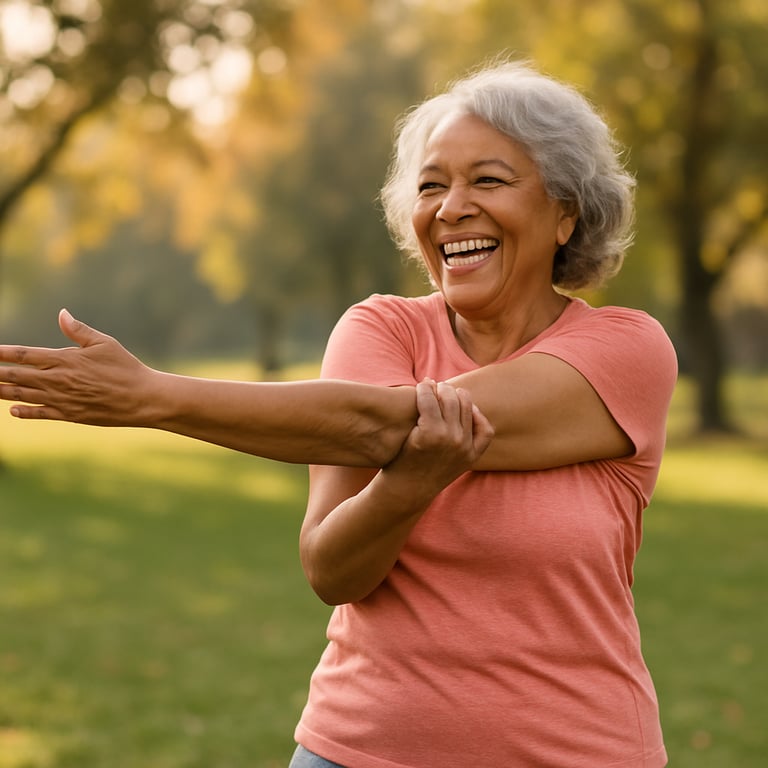Micro-Workouts, Mega Benefits: How Tiny Bursts of Movement Can Boost Longevity and Brain Health
Micro-workouts and “movement snacks” may boost longevity and brain health, says NIH research. Learn how tiny bursts of exercise protect body and mind.
Bruce R Black
10/13/20254 min read


Micro-Workouts, Mega Benefits: How Tiny Bursts of Movement Can Boost Longevity and Brain Health
So you hate long workouts? Perfect. Science says you’re doing it right.
Recent studies from the National Institute on Aging (NIA) and several universities are shaking up how we think about fitness for seniors and active agers. You don’t need to spend an hour sweating in a gym or drag yourself through a marathon workout. It turns out that short, frequent bursts of movement — “micro-workouts” or “exercise snacks” — may be one of the most powerful anti-aging tools we’ve got.
Two significant research threads now back this up:
The “snacktivity” approach, where 2-3-minute spurts of exercise throughout the day add up to meaningful fitness gains.
The cognitive benefit angle, where even 5 minutes of brisk movement is associated with a lower risk of dementia and improved brain blood flow.
Translation? You can stay strong, sharp, and independent — without ever having to join a CrossFit class.
The New Science of Small
For years, exercise guidelines have recommended “150 minutes a week” — but that phrase often scares off many people. What if, instead, you just did 2 minutes of movement here and there, whenever the moment struck?
🧠 Study #1: The Snacktivity Revolution
Researchers from the University of Sydney analyzed accelerometer data from over 25,000 adults (published in Nature Medicine, 2023). They found that people who got just 3 short bursts of vigorous activity a day — around 1 to 2 minutes each — had up to a 49% lower risk of death from cardiovascular disease or cancer.
👉 Read the research summary from Nature Medicine
In other words, climbing the stairs, briskly walking the dog, or doing a few squats while the coffee brews count.
🧩 Study #2: Move for Your Mind
A 2024 National Institute on Aging update found that short, moderate-to-vigorous physical activity (MVPA) episodes — as little as 5 minutes daily — were strongly linked to lower dementia risk in older adults. Researchers believe this “mini-movement” effect helps keep blood flowing to the brain and stimulates growth factors that support neurons.
👉 NIH / NIA article on movement and brain health
So yeah, those quick walks or impromptu dance breaks? They’re literally rewiring your brain for longevity.
Why Short Works (and Long Isn’t Always Better)
Think of your body like a solar panel. It needs regular bursts of sunlight, not one giant sunburn.
That’s how movement works, too: your muscles, heart, and brain prefer consistent micro-doses of activity instead of long gaps of sitting followed by a punishing workout.
Here’s what happens when you move, even briefly:
🩸 Your blood vessels dilate, improving circulation and delivering oxygen to the brain.
🧬 Your mitochondria activate, which helps slow cellular aging.
🧠 BDNF (brain-derived neurotrophic factor) levels rise — think of it as “Miracle-Grow” for neurons.
🔥 Your metabolism wakes up, helping with blood sugar regulation and fat balance.
That’s the “anti-aging exercise effect.” You’re telling your body, Hey, stay alive, we’re still using you!
What Counts as a Micro-Workout?
Almost anything — as long as it makes you breathe a little harder or challenges your muscles. The idea is to sprinkle movement throughout your day instead of saving it for one big block.
Examples of “movement snacks”:
March in place while brushing your teeth.
15 bodyweight squats before your morning coffee.
A brisk walk around the block after lunch.
Farmer’s carries (grab two grocery bags, walk tall).
Pushups on the counter or wall.
2 minutes of stair climbs before dinner.
Dance breaks — yes, even to “Sweet Caroline.”
Every burst adds up. Studies show that accumulated activity has nearly identical health benefits to continuous sessions, especially for heart and metabolic health.
The Brain-Body Connection
We’ve talked about muscle and mobility, but let’s zoom in on what’s happening upstairs. Exercise — especially in these small doses — is increasingly recognized as neuroprotective medicine.
According to the NIH and Frontiers in Aging Neuroscience, movement triggers molecular cascades that:
Increase cerebral blood flow,
Promote synaptic plasticity (how neurons connect), and
Reduce neuroinflammation, one of the culprits in Alzheimer’s disease.
Even better, short bursts are more sustainable — meaning you’ll actually stick with them, and consistency is the real magic.
How to Turn Micro-Movement Into a Lifestyle
Let’s make this practical for active agers (and anyone who refuses to let time be the boss of them).
💡 The “5-by-2” Rule
Aim for five mini-sessions a day, roughly 2 minutes each. That’s it.
Morning: Bodyweight moves while coffee brews.
Midday: Brisk walk to the mailbox.
Afternoon: Shoulder rolls + wall pushups.
Evening: Light resistance band circuit.
Before bed: Stretch or mobility flow.
Congratulations — that’s 10 minutes of solid movement, and your heart, joints, and brain just sent you a thank-you note.
Strength Still Matters
Cardio bursts are great, but strength training for seniors remains the backbone of healthy aging. Muscle loss (sarcopenia) is one of the biggest drivers of frailty, balance problems, and metabolic decline after 60.
So, sneak resistance into your micro-workouts:
Keep a resistance band near your desk or recliner.
Do calf raises or biceps curls while watching TV.
Try one heavier lifting session a week (even 20 minutes counts).
Your 10-minute Beat Age With Ease workout is the perfect complement — consider it your “main course” among all those delicious movement snacks.
Micro-Movement Meets Mindfulness
Here’s the bonus most people overlook: when you move often, you reconnect with your body’s rhythm. It’s meditative.
Try this little trick: every hour, stand up, take three deep breaths, and move your body for one minute — stretch, twist, walk, or sway. It’s movement and mindfulness. The combo reduces cortisol (your stress hormone) and boosts mood chemistry (dopamine, serotonin).
It’s science with a side of soul. Learn more at our sister site, beathatewithease.com
Quick FAQ
Q: Is this just NEAT (non-exercise activity thermogenesis)?
A: Similar! NEAT includes fidgeting, cleaning, and daily movement. Micro-workouts are slightly more deliberate — you’re pushing intensity just enough to raise your heart rate.
Q: Can I replace all exercise with micro-workouts?
A: Not entirely. You’ll still benefit from structured movement 2-3 times per week (like your 10-minute strength routine). But if you miss a session, your “movement snacks” keep you covered.
Q: Does it really help the brain that much?
A: Yes. Exercise increases BDNF and enhances vascular health — both critical for preventing cognitive decline and Alzheimer’s disease. Even small, regular activity keeps those neuroprotective pathways active.
Bottom Line
Movement is medicine. And you don’t need a prescription — just a reminder to stand up and move more often.
Science says the key to anti-aging and brain health isn’t in a pill, supplement, or miracle gadget. It’s in your daily rhythm — how often you tell your body, “We’re still in this game.”
So take the stairs, do the squats, dance in the kitchen. Every small step sends a big message to your brain:
“We’re alive, and we’re not done yet.”
Beat Age With Ease
Empowering seniors to achieve fitness and health.
© 2025. All rights reserved.
"Disclaimer: The fitness and exercise information provided on this website is intended for educational purposes only. It is not a substitute for professional medical advice, diagnosis, or treatment. Consult your physician or a qualified health provider before starting any exercise program. The use of any information provided on this site is solely at your own risk. We do not assume liability for any injuries or health issues that may result from using our content."
💛 Found something helpful? Sharing is free, but if you’d like to keep the lights on and the ideas flowing, you can buy me a coffee below.
